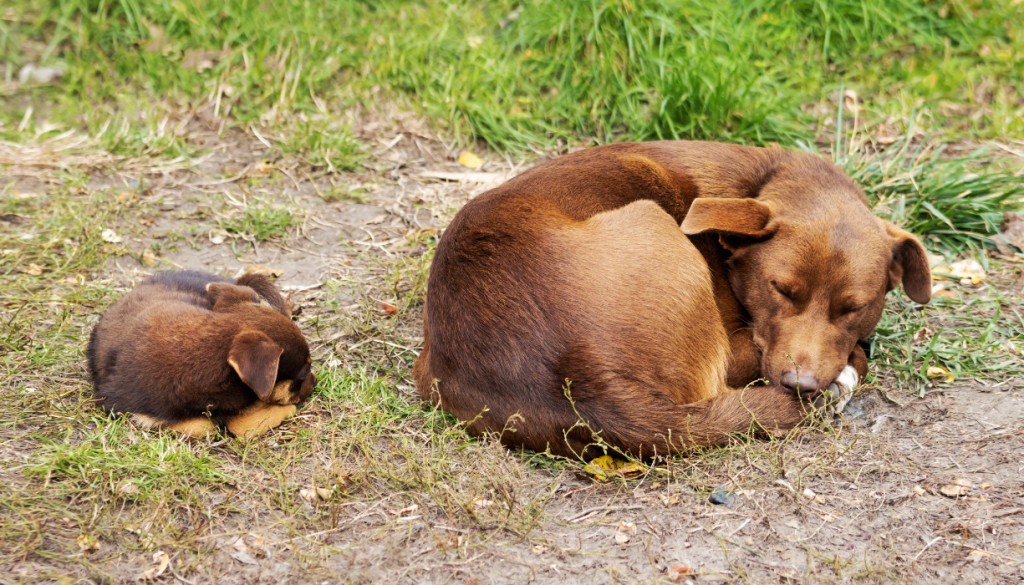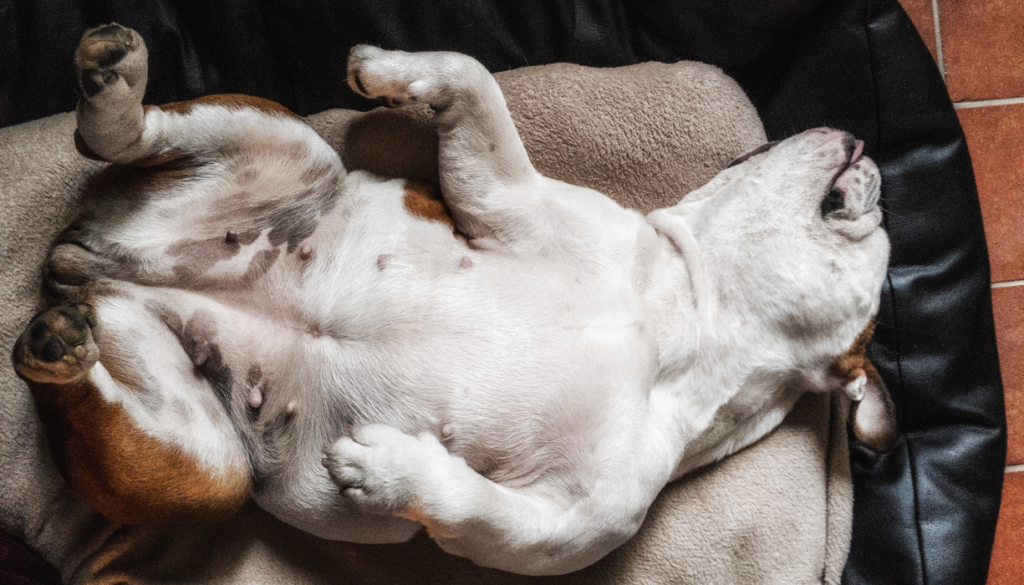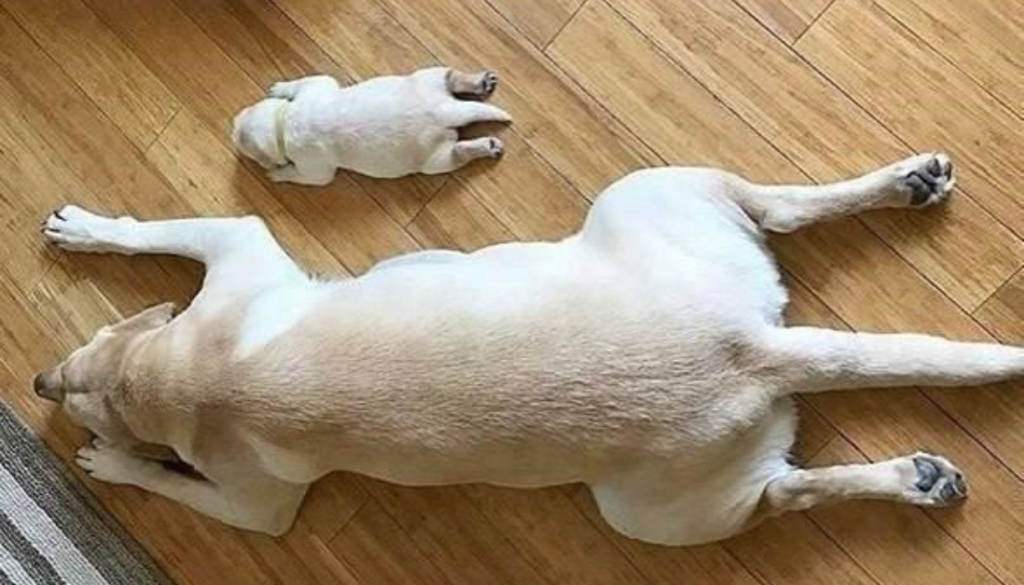Have you ever wondered why your dog chooses one sleeping position over another? The truth is, this choice isn’t random, and it reveals more than you might think.
In this article, we’ll explore how each of your dog’s sleeping positions can uncover secrets about their health and emotions.
1. The Side Sleeper

This position is not only a sign that your dog feels comfortable but also that they are in a safe and peaceful environment.
Lying on their side and stretching their legs, they seek comfort and also expose their belly, their most vulnerable spot. This is a clear sign that they feel protected with you and at home.
Additionally, in this position, your dog enters deep sleep, and you might see their little legs moving as if they were running.
If you see your dog sleeping this way, it’s best not to disturb them, as it is crucial for their rest that they complete these cycles of deep, restorative sleep.
2. The Donut

Also known as the snowball position, this is a sign that your dog is seeking comfort or security. When your pet curls up in this compact shape, they are trying to conserve heat and protect their vital organs.
This position is common in dogs during colder months or in situations that cause them uncertainty.
If you notice your dog frequently adopts this posture, it might indicate that they feel insecure or simply cold. In these cases, make sure to provide a warm and reassuring environment.
This position is not only a strategy to stay warm but also a signal that your buddy might need a bit more affection and protection.
3. The Belly Up

This posture is my favorite. When your dog sleeps on their back, with their legs in the air and belly exposed, it’s because two conditions are met: it’s warm, and they are completely relaxed.
Although this position might seem odd to us, it’s a clear indication that your dog feels utterly secure and confident in their home.
By exposing their most vulnerable parts like the belly and throat, your dog is showing absolute trust in you. Moreover, this position helps them cool off, as dogs release heat through their belly and the inner part of their legs, where they tend to have less fur.
If your dog often chooses this position, take it as a good sign: it means they feel loved, secure, and can easily adapt to their environment.
4. The Superman

The Superman position, with the front legs stretched out and the hind legs extended backward, is a posture your dog might use to cool off or simply rest after intense play.
This posture allows the belly, an area with less fur, to make direct contact with cool surfaces, providing instant heat relief.
That’s why it’s normal to see them sleeping in this position directly on the floor, rather than on their bed or a blanket as they usually do.
Although it’s not the most suitable posture for long, deep sleep, it’s perfect for a quick nap. If your dog lies down this way, they are likely ready to jump up and continue playing at any moment.
This is very common in puppies and very active dogs who don’t want to miss a second of fun.
5. The Lion’s Pose

This posture, also known as the sphinx, reveals an interesting fact about your dog’s rest.
We call it this when your furry friend lies down with their head on their front paws, and what happens is that they are resting rather than sleeping deeply.
This pose allows them to be ready to get up quickly, which is useful if they need to respond soon to some stimulus.
It’s common for dogs to adopt the lion’s pose near strategic places, like near your feet or the front door, always staying alert.
If your dog prefers this position, they are displaying their protective instinct, ensuring they are always available if you or your home need their attention.
6. The Burrower

Does your dog disappear under the sheets every night? This curious preference for sleeping hidden under the blankets is called the burrower position, and it reflects their need for comfort and security.
When your dog seeks the shelter of the sheets, they are looking for warmth when it’s cold but also companionship and protection.
If your furry friend prefers this position, consider it a sign that they need a safe space where they can relax deeply.
7. Back to Back

When your dog chooses to sleep with their back against yours, they are expressing a very special connection with you.
In ancient times, sleeping huddled together in burrows was a way to protect themselves and keep warm. Today, when your dog chooses to sleep this way with you, they are replicating that feeling of security and belonging.
Moreover, if your dog only seeks this position with you and not with other members of the house, it’s a sign that they consider you their favorite person. It’s one of the greatest signs of affection your dog can show you.
8. Head and Neck Raised

When your dog chooses to sleep with their head and neck elevated, resting their head on the edge of the bed or a sofa cushion, they may do it for several reasons.
The most common is that it’s simply a personal preference. By slightly raising their head and neck, they may find it more comfortable, and therefore seek places where they can rest their head.
It might also be a matter of vision. By placing their head in a higher position, they enjoy a better view of their surroundings while sleeping, and also have better views when they wake up.
Though there are experts who suggest it could also be an indicator of respiratory difficulties. This is less common, but if you notice other symptoms like noisy breathing or fatigue after little exercise, it is very important to consult with a veterinarian to rule out or treat any health issues.
Why Does My Dog Keep Moving From Spot to Another?
Now, let’s analyze why sometimes dogs seem unable to find the right posture and keep moving from side to side. When your dog moves constantly during the night, they are generally trying to make their resting place more cozy.
They might do this by digging into their bed or changing positions in search of the most comfortable one for them at that moment.
They might also be looking for a more pleasant temperature, whether warmer in winter or cooler in summer.
However, if you observe that your dog is particularly restless, walking back and forth without resting properly, it could be an indication that something else is going on.
Issues like anxiety or pain can make it difficult for your dog to relax. Also, if they approach you and then walk towards the door, they might need to relieve some stomach discomfort.
In these cases, a nighttime walk might be necessary and, if the problem persists, consulting a veterinarian would be the most advisable to ensure your dog’s well-being.
How Long Do Dogs Sleep Per Day?
Just like humans, the amount of sleep a dog needs varies greatly depending on their age, activity level, and individual temperament. Here are some approximate figures based on the age of the dog:
- Puppies, with their rapid growth and development, need to sleep between 18 and 20 hours a day.
- Adult dogs typically require between 8 and 14 hours, although most sleep an average of 12 to 14 hours.
- This increases again in senior dogs, who may also need between 18 and 20 hours as their energy levels decrease.
Additionally, you should keep in mind that dogs tend to sleep more between 9 PM and 6 AM, but it’s common for them to take several naps throughout the day, especially after being active.
If your dog suddenly changes their sleep patterns, either sleeping more or less, it’s a good idea to consult a veterinarian to rule out any possible health issues.
In conclusion, understanding your dog’s sleeping positions offers a window into their physical and emotional well-being.
Each posture, from the Side Sleeper to the Burrower, reveals how they feel about their environment, their comfort level, and even their relationship with you.
By observing and responding to these signals, you can ensure your dog feels safe, secure, and loved. Whether it’s providing a warmer bed, more affection, or a quick trip to the vet, these insights can help you better care for your furry friend.
